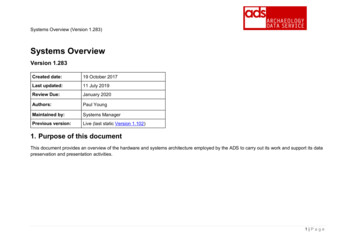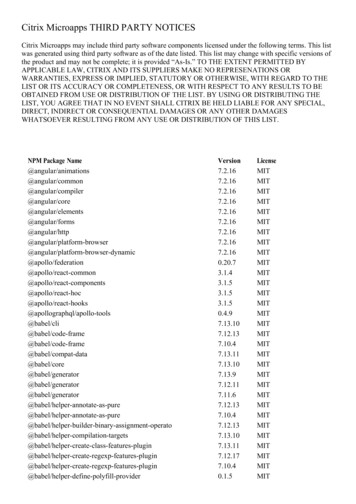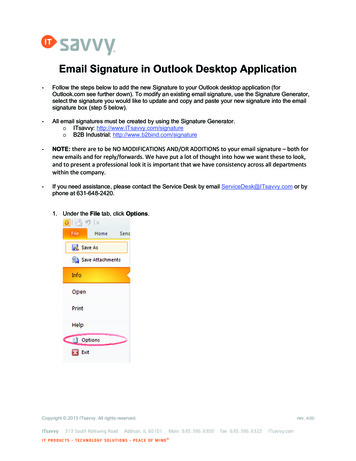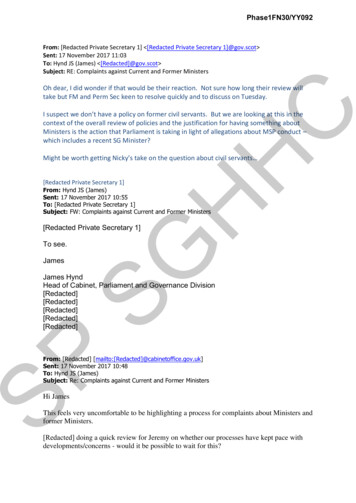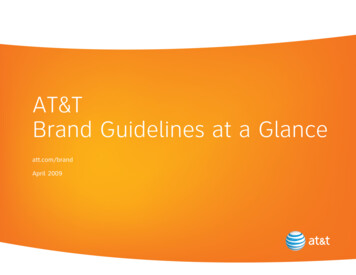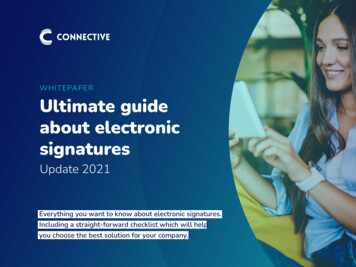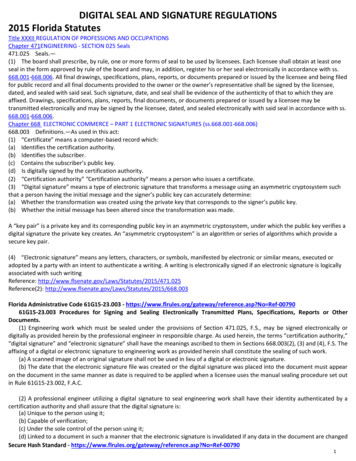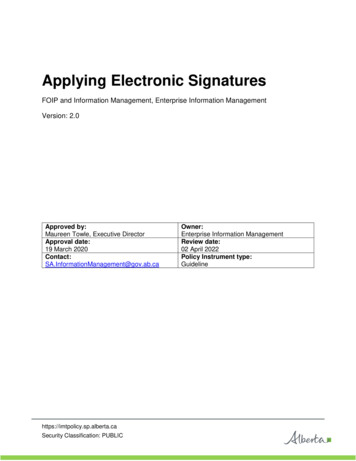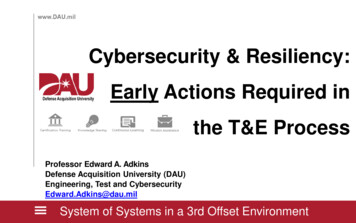
Transcription
COUNTERING SOURCE BIAS IN NEWSbyDavid Wesley Anderton-YangB.Sc., School of Oriental and African Studies, University of London (2010)Submitted to the Program in Media Arts and Sciences, School of Architecture and Planning, inpartial fulfillment of the requirements for the degree ofMaster of Science in Media Arts and Sciencesat theMassachusetts Institute of TechnologySeptember 2019 Massachusetts Institute of Technology, 2019. All rights reservedSignature redacted.Au th o r .Signature redacteds,Program in Media Arts and SciencesN .4August 8th, 2019.C ertified by .Andrew LippmanSenior ResearchSciSignature redacted.Accep ted by .I71/1Tod MachoverMASSACHUSETTS INSTI-TUTEdOFSECHNOLOGY TAcademic Head, Program in Media Arts and SciencesOCT 0 4 2019I IRRARIFAhA1
2
COUNTERING SOURCE BIAS IN NEWSbyDavid Wesley Anderton-YangSubmitted to the Program in Media Arts and Sciences, School of Architecture and Planning, onAugust 8th, 2019, in partial fulfillment of the requirements for the degree ofMaster of Science in Media Arts and SciencesAbstraCtFacts don't speak for themselves. What we accept as fact and the truth we derive from it arestrongly dependent on both our opinion of the source and the agent of recommendation; how weencountered the information. In an increasingly nationalized and fragmented society, therepresentation and presentation of news functions less to build a shared set of values and beliefsand more to drive a wedge between groups that precludes discussion. These trends arewell-known and long-lived, but are critically important now because the Internet has intensifiedthem by multiplying niche sources and amplifying the role of recommendation. The centralquestion of this thesis is what we can do about it - whether we can create media presentationsand interactions that encourage us to explore the diversity that the Internet brings, and whetherthere is a "teachable" moment in doing so. For example, will we temper deeply held opinionswhen we explore sources we don't normally attend? I present an attempt to do this that firstallows users to establish a set of sources ranked by personal trust and then second, allows themto blindly compose their own news stories from the suite of them. I consider two outcomes:whether they soften otherwise hardened opinions after they note their own acceptance of whatthe "other side" says, and whether this approach might scale through passing these newcompositions onwards to propagate the idea. I find that there is a clear disconnect betweenparticipants trust in news sources and the sources they utilize to create an objective story. Thisdisconnect is much more severely noted in those participants who self-identified as left-leaningpolitically.Thesis advisor:Andrew LippmanSenior Research Scientist3
4
Countering Source Bias in NewsbyDavid Wesley Anderton-YangThis thesis has been reviewed and approved by the following committee membersSignature redactedAndrew Lippm an .//.ISenior Research Scientist,MIT Media LabSignature redactedD a n n y H illis . .--.Visiting Professor,MIT Media LabSignature redactedJoiIto .Director,MIT Media Lab
Table of Contents9Chapter 1 ContextChapter 2 Existing work15Chapter 3 System description21Chapter 4 Evaluation35Chapter 5 Discussion47Chapter 6 Future work51Chapter 7 Final notes57Bibliography597
AcknowledgementsTo the Viral Communications group many thanks for all the exciting and engaging discussions,being a home, and providing several desks! Special thanks to Hisham, Mike, Kalli for theirfeedback and timely support. Also others at MIT including Trish and Bill at the Trust Center.Thanks to Jarek, Mike, Dave, Todd, Martin, Tyler and Carol from MIT DAPER whoseinstruction and thoughtfulness brought balance to my academic life, several ice hockey injuries,and a pirate certificate. Jarek, I won't ever forget the laughter erupting in class when you askedwhere I learnt a parry and I replied: "Lightsabre Club". Such is MIT.Many thanks to those who provided guidance and countless hours of input as I explored how toadd value to the academic discussion around profiles, understanding of trust, and news. Joi,Danny, and Deb at the Lab, Brian in the Auto-ID Lab at MIT, and Doc of the Berkman KleinCenter. Also thanks to all those who were working behind the scenes to make this a success.Andy, thank you for the many frank conversations where in the crucible of discussion everythingwas burned away beside a pure and clear product - what needed to be done.-Heartfelt thanks to all my friends who have put up with me being late, disorderly, thinkingTuesday is Wednesday, and handing out rain checks that couldn't be cashed in. Now they canhopefully not all at once! Nicky, Lin Lin, Abbie, Mike, Sophia, Junsu, Joanne that includes you!Also to friends, colleagues, and connections present and past who inspired me forward on thispath. Chi-Chu, Wendy, Priyanka, Noemi, Bea, Stefan, Gordon, Vivian, and countless others.It is not possible to fully make acknowledgements to family in this space, I will be making a tripto see you shortly both to LA and to the UK. Patience and unrelenting support has been ablessing that has not been overlooked. Vanessa, Mike, Ann, Sandy, Steven and Grace yourkindness, generosity, and prayers have made this journey possible and all the more inspiringand exciting.Final thanks and appreciation go to my wonderful wife, Alice, who was also going throughprofessional exams for acceptance into the Massachusetts Bar during this time. She has been anunyielding steadfast support, sounding board, and exceptional and diligent partner throughoutthe time we have known each other.Thank you.8
Chapter 1Context"We have a culturalproblem, one that isshaped by disconnects in values,relationships,and socialfabric.Our media,our tools, our politics are being leveragedto help breedpolarizationby countlessactors who can leverage these systemsforpersonal, economic, and ideologicalgain."danah boyd'We are told that we have entered a brave new world where "fake news" is rife. Its exact natureunknown. Its definition unclear. 2 Some believe it to be the scourge of false information, somebelieve it to be the selective presentation of true information 4 , others believe it to be anin-acurrate portrayal of the news5, and still others have split the term into a set of subgroupscharacterising the various natures of fake news'. One thing, we are told, is seemingly certain: theBoyd, Danah, Google and Facebook Can'tJustMake Fake News Disappear,Microsoft Research, DataSociety, NYU(July 1, fbe8.2 Boyd, Danah, Google and Facebook Can't Just Make Fake News Disappear,supra.3 Video: Spotting Fake News, FactCheck.Org: FactCheck Posts (June 28, ting-fake-news/?gclid D BwE.4Scheufele, Dietram A. and Krause, Nicole M., Science audiences, misinformation, andfake news, PNAS:Proceedings of the National Academy of Sciences of the United States of America, vol. 116, no. 16(2019).5 Grynbaum, MichaelM., Trump Discusses Claims of'Fake News,'and Their Impact, With New York&1Times Publisher,The New York Times (July 14, media/donald-trump-interview-news-media.html.6 Wardle, Claire, Fake news. It's complicated., First Draft (July icated/.9
viral spread of this pariah has been enabled by the technology giants of today 7. Innocent, wellmeaning, bystanders inadvertently share news stories manufactured to order by variousnefarious agents opposed to our best interest' - enabled by the lack of friction in the platformsthese giants have made their fortunes from. The solution many point to is a simple fix: if onlythe tech giants allowed impactful content that was factually true to be shared, and banned thosewho create false content, this pariah would be solved.In a Pew study of 6,127 U.S. adults from early 2019, a higher percentage of Americans said that"made up news" was a more serious issue for the U.S. than climate change and terroism. Thedebate around "fake news" has spawned conferences across the globe, discussions on how tomitigate the consequences, and claims by both ends of the political spectrum that they aresubject to an unfair and unyielding disadvantage from its effects. Indeed, both ends of thepolitical spectrum have been accused of equipping these tools for their own gains; hailing in anera of "by any means possible"111.However, despite popular opinion seeming to suggest otherwise, this is not a problem with itssource solely online". The underlying issues pointed to by discussions of fake news are a set ofsocio-economic, political, and cultural issues with a long and convoluted history'3 which the.reduced friction and interconnection of the internet amplifies immensely 4Fake News: Read All About It (In The Headlines), New York Times Educational Publishing (August 15,72018).Burkhardt, Joanna M., Chapter2: How Fake News Spreads, Library Technology Reports: CombatingFake News in the Digital Age, vol. 53, no. 8 (2017).9 Shane, Scott and Blinder, Alan, Democrats Faked Online Push to Outlaw Alcohol in Alabama Race, TheNew York Times (June 12, s/alabama-senate-facebook-roy-moore.html.1 Narayanan, Vidya, Graphika, Vlad Barash, Graphika, John Kelly, et al., Polarization,PartisanshipandJunk News Consumption over SocialMedia in the US, COMPROP: Computational Propaganda ResearchProject, Data Memo 2018.1 (2018)." Harper, Craig and Baguley, Thom, "You are Fake News": Ideological (A)symmetries in PerceptionsofMedia Legitimacy, Nottingham Trent University (UK) (January 23, 2019)." Boxell, Levi, Gentzkow, Matthew, and Shapiro, Jesse M., Is the Internet Causing PoliticalPolarization?Evidencefrom Demographics,The National Bureau of Economic Research (NBER), Working Paper No.823258 (2017).3 Boyd, Danah, Google and Facebook Can'tJust Make Fake News Disappear,supra.Reed, David P., Biography, Reed's Locus (July 12, 2019),https://www.deepplum.com/dpr/?sel dprbiog.1410
4Fake news and the collection of issues embedded within that term, are not limited to theinternet. They are, also, not limited to the content. As highlighted in the image below, "CNN IsFake News", fake news has evolved to mean not only the content, but also increasingly thesource. Content is no longer king" and 70% of Republican leaning and 59% of Democrat leaningAmericans have blocked out a news source in an effort to tackle their consumption of fakenewsFigure 1-1o: Photo by Elijah Nouvelage for ReutersI focus my experiment on the following characteristics that I believe are so far not duly notedwithin the discussions surrounding fake news and its evolution today:- The dichotomy of opinion and fact doesn't hold water - it is no longer just about opinionor facts, but whose facts.-iWe all have a partial view of reality, but believe we see the big picture; there is less effortto appreciate the views of the "other side".5 Odlyzko,Andrew, Content is Not King, First Monday: Peer-Reviewed Journal On The Internet, vol. 6,no.2(2001).Mitchell, Amy, Gottfried, Jeffrey, Walker, Mason, et al., Many Americans Say Made-Up News Is aCriticalProblem That Needs To Be Fixed, Pew Research Center: Journalism &Media (June 5,2019).1611
-There is a disconnect between the sources we believe are objective and the content thatwe deem to provide objectivity.With the above understanding, I believe we should continue to explore the extent of the power ofsource perception on the pre-judgement of content, and seek to challenge ourselves and othersto evaluate how we are switching off our attention to news sources based on their affiliationsrather than on the content that they are producing. This switching off of news sourcesconsidered to be "fake" is leading to a growing void of understanding and appreciation of theviews of others that is becoming harder and harder to bridge between different politicalleanings.The main question that drives this thesis is: How can we prompt a re-evaluation of ourprejudices to news sources we believe to be untrustworthy?Indeed there are many parameters that could play a role in shaping an individual's trust of anyparticular news source:-Source branding-Credibility and trust of others in network-Political leaning of source-Reputation of the sharers who share stories from a source-The context under which a news source is consumed-The initial biases of the reader-The topic matter being discussed-The bucket of words used to construct a story-Stylistic cues within writing-Visual cues and imagery-Impact of major national polarizing events such as an election-If the user is recommending or sharing an article-Collaborative consumption of news in a public settingMany of the non-exhaustive list above have already been explored and are detailed further in thefollowing chapter.12
In this thesis, my approach is to explore how our trust of news sources is related to ourperception of the source and its affiliations rather than our perception of the quality of thecontent produced by the source. I propose to do this through:1.Exposing individuals to content from a variety of their trusted and untrusted newssources with the name of the source hidden;2. Asking them to create what they believe to be an objective story about a particular topicutilizing content they select from both trusted and untrusted sources;3.Prompting a moment of self reflection on biases by revealing the sources of the contentthat they used to create their objective account of a topic; and4. Quantitatively and qualitatively evaluating the disconnect between individualsperception of sources as trusted or untrusted, and their utilization of those sources'content to create a story they believe is objective.In the following chapter, I describe the existing work that has explored several relevant areas tothis thesis: identifying news sources from content; tribalism and trust; and, credibility andreceptiveness. These existing works form a strong foundation on which to both build theexperiment this thesis conducts and to reason and postulate as to potential contributors to theresults encountered.13
14
Chapter2Existing workIn this chapter, I describe the existing work that has explored several relevant areas to thisthesis: identifying news sources from content; tribalism and trust; and, credibility andreceptiveness. In the chapter prior, I introduced the question this thesis seeks to explore: Howcan we prompt a re-evaluationof our prejudices to news sources we believe to beuntrustworthy?In the next chapter, I detail the toolbox I created for individuals to composestories including its genesis, structure, and realization.Identifying news source from contentExploring how news sources can be identified through their content and styisations providesinsight into some of the findings from this thesis, as discussed later within Chapter Five. Asmuch as content can be recalled from both trusted and untrusted sources, there is an inbuiltresistance to material presented by an untrusted source 7 . Interestingly, the blind media biassurveys from AllSides composed a picture of news sources on the political spectrum, indicatingthat political lean can at scale be determined from content alone'.Previous work within the Viral Communications research group at the MIT Media Lab hasilluminated, although not definitively, some of the potential avenues through which newssources could be identified through their content. NewsClouds, a project by Thariq Shihipar,showed how as a news story develops the lexical set utilized by a news source expands andevolves. His findings entailed multiple news sources that started off by sharing use of key termsabout a story and then, as the story developed further, news sources relied on more disparateCarl I. and Weiss, Walter, The Influence ofSource Credibility on CommunicationEffectiveness, Public Opinion Quarterly, vol. 15, no. 4 (1951).18 Media Bias Ratings, AllSides (June -bias-ratings.17Hovland,15
and unique buckets of words 19. Slantometer, a project by Kalliroi Retzepi, drew attention to adiffering nature of composition of news articles between left and right-leaning news sources andencouraged further more complete exploration of the noted trends. Slantometer found thatleft-leaning media sources presented select facts intertwined with context and added a subtleopinion throughout, whereas right-leaning media had a tendency to cleanly separate paragraphsof select facts from paragraphs of clear opinion - with less contextual wrapping unless directlyrelevant to the news event.Tribalism and trustA selection of studies have questioned how our understanding of trust in news sources is relatedto the groups and individuals we associate with those sources. In one such experimental study,the authors found that given identical generic content: if a participant disliked the news source,then they disliked the content. If they like or don't know about the source, decisions about thecontent were based on the person who shared it. A trusted sharer resulted in believing that thecontent got the facts right, represented diverse points of view, was entertaining, and signpostedimportant and trustworthy information regardless of the content itself . We no longer disagreejust over values, nor do we disagree over just the facts. We disagree over whose source - whosefountain of facts - is the right one".Most interestingly, for the purpose of this thesis, the authors from the above-mentionedexperimental study noted a disconnect: participants believed that, to them, the news-organization and brand that reported the story was more important than who shared ithowever the experiments showed that, with identical content, the sharer influenced perceptionof the content far more than the source. This thesis argues that this disconnect is not limited tothe sharer and the source, but extends to the source versus the content - that there is asignificant disconnect between the sources we trust and the content we trust.Shihipar, Thariq, NewsClouds (July 3, 2019), https://v3.pubpub.org/pub/newsclouds.Rosenstiel, Tom, Sonderman, Jeff, Loker, Kevin, et al., 'Who sharedit?': How Americans decide whatnews to trust on social media, American Press Institute: Media Insight Project (2017).21 Lynch, Michael P., Googling Is Believing: Trumping the InformedCitizen, The New York Times e-informed-citizen/.16
This disconnect also extends to how we sanction news sources for their use of clickbait headlinesto grab attention and pull in the reader - to an often tagentally or unrelated content. Newssources that the individual already perceives as low credibility see a significant decline incredibility. News sources with a high preexisting credibility get more or less a free pass for their.use of clickbait and suffer much less of a decline in credibility2 2A seemingly timeless case study, entitled "They Saw a Game", explored the controversy and setof disagreements over what actually took place during a 1951 football game between Dartmouthand Princeton 2 3. The results of a survey of undergraduates at both institutions suggested thatthe "game" was in fact many different games - each independently as real to the person whoexperienced it. The study highlighted how as individuals, we believe we have an objective andcomplete view of reality, yet in actuality, we each only have access to a slice. Each individualhaving their slice feel just as real and complete, as others and the reality of their slice. Of mostinterest to this thesis was firstly that those who had never seen the game had their own set ofrealities that were consistent with the team they were affiliated with. Secondly, after one of thesets of Princeton students interviewed had marked down penalty offences within a segment ofvideo, a Dartmouth alumnus in the Midwest (who had been in receipt of infractions list andvideo) wired a note to Dartmouth college: "Preview of Princeton movies indicates considerablecutting of important part please wire explanation and possibly airmail missing part beforeshowing scheduled for January25we have splicing equipment". The video had not been cut.This highlighted that even within a short video clip two seemingly incongruous realities couldco-exist.Factual beliefs on climate change, evolution and the like can also often be symbols used tocommunicate membership in and loyalty to groups embroiled in a competition for social status.Often holding group consistent beliefs - a belief in line with the conventional and acceptedopinion about a topic of a group in which an individual is a member of - is more important thanholding true ones 2 4. Increasingly alignment to a side on a matter of national scale determines" Hurst, Nathan, To Clickbait Or Not To Clickbait?An ExaminationOf ClickbaitHeadline Effects OnSource Credibility, University of Missouri-Columbia (May 2016).23 Hastorf, Albert H. and Cantril, Hadley, They Saw A Game: A CaseStudy, The Journal of Abnormal andSocial Psychology, vol. 49, no. 1, pp. 129-134 (1954).24 Kahan, Dan, The Meaning of Scientific "Truth"in the PresidentialElection, Scientific American (June18,2019),17
this group membership - with more and more of politics now seemingly national2 5, no longerjust local2 6. One study where 600 participants were presented with different hypotheticalscenarios for redistribution of resources in a community show that participants drew similarconclusions about when redistribution was appropriate regardless of political leaning, and thatdiffering in views for appropriate action for their own community may be based upon a differingview of which bucket the status of their community falls into 7 . Holding group consistent beliefsor perspectives also carries less downside risk: an objective article from CNN as perceived by aright-leaning person carries a high risk of being ostracized if shared, where as the risk of beingostracized for aligning with a Breitbart article later found incorrect is low. And vice versa, aleft-leaning individual arguing that a particular Breitbart article is well researched faces the riskof a massive backlash and being alienated, whereas supporting a hastily reposted CNN articlethat may be factually inconsistent carries minimal risk.The studies above point to a broader more concerning trend that Lessig, in his book AmericaCompromised, calls out to be addressed: Whereas media technology was previously an enablerfor democratic discourse, now it divides us. The media doesn't focus us on a common core offacts, values and beliefs, but divides us over our view of the facts - with supporting businessmodels that profit from this very division2. This is by no means an entirely internet basedphenomena either - this polarization has increased most significantly in communities less likely.to be connected to the internet -election/.25 Hopkins, Daniel J., The Increasingly United States: HowAnd Why American PoliticalBehaviorNationalized, The University Of Chicago Press Books (May 2018).26 O'Neill, Tip and Hymel, Gary, All Politics Is Local: And OtherRules Of The Game, Bob Adams, Inc.(1994).Nettle, Daniel and Saxe, Rebecca, PreferencesFor RedistributionAre Sensitive To Perceived Luck,27Social Homogeneity, War and Scarcity, PsyArXiv Preprints (July 23, 2019).Lessig, Lawrence, America Compromised, The University Of Chicago Press Books (October 2018).Boxell, Levi, Gentzkow, Matthew, and Shapiro, Jesse M., Is the Internet Causing PoliticalPolarization?Evidencefrom Demographics, supra.282918
Credibility and receptivenessAs consumers of news, we tend to seek out attitude-consistent information and avoidattitude-challenging information 3 0. Judging attitude-consistent and neutral news sources asmore credible than attitude-challenging news sources 31. Indeed, as alluded to in Chapter One,many of the sources that may be attitude-challenging to us are increasingly blocked out by bothperceived fake news by blocking select news sources out entirely3.how we consume news through technology and how we might look to mitigate issues ofThe context of news consumption also impacts the credibility of news sources with a tendencytoward news sources being perceived overall as more credible during election times andsignificant national events 33 . As lines between varieties of content are blurred and our ability todistinguish between them reduced3 4, such as between news, sponsored content, and advertising,there is a comingling of the credibility of advertisements placed on the page and the credibilityof adjoining content from the news source.Credibility can also be a feature of timing. Studies have shown that if a reader is exposed to thecontent from a news source that they deem to be untrustworthy, they automatically discount it.However, as time passes, an increasing disconnection between the source and the content occursand the reader becomes more acceptant of the content despite origination from an.untrustworthy news source5The goal of this thesis is to provide an answer to the question: How can we prompt are-evaluationof our prejudices to news sources we believe to be untrustworthy? Proposals30 Metzger, Miriam J., Hartsell, Ethan H., and Flanagin, Andrew J., Cognitive Dissonanceor Credibility?:A Comparisonof Two TheoreticalExplanationsforSelective Exposure to PartisanNews, SAGE Journals(November 26, 2015).31 Metzger, Miriam J., Hartsell, Ethan H., and Flanagin, Andrew J., Cognitive Dissonance or Credibility?:A Comparisonof Two TheoreticalExplanationsforSelective Exposure to PartisanNews, supra.32 Mitchell, Amy, Gottfried, Jeffrey, Walker, Mason, et al., Many Americans Say Made-Up News Is aCriticalProblem That Needs To Be Fixed, supra.33V., Abdul Muneer and Ahmed, Syed Amjed, CredibilityPerception of TVNews and Debate ShowsBefore and During Election Campaigns, IOSR Journal Of Humanities And Social Science (IOSR-JHSS),vol. 19, no. 4, ver. VIII, pp. 47-54 (April 2014).34EvaluatingInformation: The CornerstoneOf Civic Online Reasoning, Stanford History EducationGroup (November 22, 2016).35Hovland, Carl I. and Weiss, Walter, The Influence ofSource Credibility on CommunicationEffectiveness, supra.19
from the various works listed on how to address prejudices and disconnects in our consumptionof news are lacking or set to take many lifetimes of work. One such proposal suggests: "A new setof institutions,practices and norms aimed at preventing the entanglement offactual positionswith cultural identities, and disentanglingthem when preventative effortsfail"36 . A noble goal,yet with no further discussion of how to actuate such societal level change. Other moreachievable and invigorating proposals have focused more on the nature of potential stepsforward, suggesting we build tools to understand, appreciate, and bridge different viewpoints.rather than relying on information alone to guide the way 37In the following chapter, I detail the toolbox I created for individuals to compose stories from avariety of material from their trusted and untrusted sources as an attempt to prompt momentsof self-realization about how we characterize news sources as trusted or untrusted. The sourcesfrom where content was drawn remain unknown until after the story is completed. Thisattempts to spur internal discussions about whether we should open ourselves to other anduntrusted news sources, bringing to light our underlying thought processes and biases.36Kahan,37Boyd,Dan, The Meaning of Scientific "Truth" in the PresidentialElection, supra.Danah, Google and Facebook Can'tJustMake Fake News Disappear,supra.20
Chapter 3System descriptionIn this chapter, I describe the process through which the story toolbox was created, thendescribe the infrastructure that supports the toolbox, and, finally, detail the implementation anduse of the system. In the chapter prior, I reviewed existing work and in the following chapter Iexplore the results of participants using the story toolbox both qualitatively and quantitatively.The story toolbox is an online software that presents the user with the ability to create a newstory utilizing existing articles from five different news outlets on a particular topic. This newstory has seven constituent elements: title; header image; and five paragraphs of content. Thestory toolbox was used by participants on a laptop at several locations on MIT campus and in theBoston area.Ideation processThis is the story toolbox as used by participants at the end of the ideation process:21
Figure 3-1: a user creating a story with final version of the online story toolboxI was initially curious about building an individually tailored news experience to people thatwould deliver a more complete understanding and picture of what is happening in the world,beyond the particular bias and perspective of any one news outlet or dominant view. Alongsidethis effort to expand the access to differing perspectives, was an effort to increase the opennessof users to these other perspectives, cueing self-reflection and re-evaluating the currentpositioning in the user's mind that had developed over time for the available sources of news.In order to tailor news spec
danah boyd' We are told that we have entered a brave new world where "fake news" is rife. Its exact nature unknown. Its definition unclear.2 Some believe it to be the scourge of false information, some believe it to be the selective presentation of true information4, others believe it to be an

